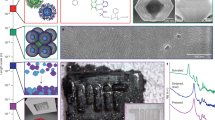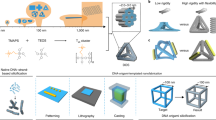Abstract
Although silica nanoparticles are used as building blocks in nature and synthetic mesostructures, the influence of nanoparticle characteristics on the assembly and disassembly of mesostructured silica has not been investigated. We demonstrate that nanoparticle size and size distribution allow us to control the assembly of silica-type mesostructures and that, because of the discrete nature of nanoparticles, we can disassemble these mesostructures into a rich variety of structural building units. When assembling mesostructures, nanoparticles undergo size-dependent segregation once the nanoparticle diameter exceeds a critical size threshold, which is approximated by the root-mean-square end-to-end distance of the hydrophilic block of the block copolymer. Using this phenomenon, we direct gold–silica core–shell nanoparticles into the segregated regions of silica-type mesostructures, demonstrating the ability to precisely place nanoparticles and create compositionally heterogeneous, functional mesostructures. We further show that, because the mesostructures are composed of nanoparticles, they can be disassembled into nanotubes, hexapods and other complex, well-defined structural units, thereby introducing the concept of retrosynthesis to materials chemistry. Our results demonstrate how nanoparticle characteristics influence the structure and properties of nanoparticle-derived mesostructures. Size-dependent segregation and disassembly should improve structure control at the near-molecular level and should be applicable to a wide range of nanoparticle-derived mesostructures.
This is a preview of subscription content, access via your institution
Access options
Subscribe to this journal
Receive 12 print issues and online access
$259.00 per year
only $21.58 per issue
Buy this article
- Purchase on Springer Link
- Instant access to full article PDF
Prices may be subject to local taxes which are calculated during checkout




Similar content being viewed by others
References
Simpson, T. L. & Volcani, B. E. (eds) Silicon and Siliceous Structures in Biological Systems (Springer, New York, 1981).
Aizenberg, J. et al. Skeleton of Euplectella sp.: structural hierarchy from the nanoscale to the macroscale. Science 309, 275–278 (2005).
Shimizu, K., Cha, J., Stucky, G. D. & Morse, D. E. Silicatein a: Cathepsin L-like protein in sponge biosilica. Proc. Natl Acad. Sci. USA 95, 6234–6238 (1998).
Cölfen, H. & Mann, S. Higher-order organization by mesoscale self-assembly and transformation of hybrid nanostructures. Angew. Chem. Int. Edn Engl. 42, 2350–2365 (2003).
Kröger, N., Deutzmann, R. & Sumper, M. Polycationic peptides from diatom biosilica that direct silica nanosphere formation. Science 286, 1129–1132 (1999).
Kröger, N., Lorenz, S., Brunner, E. & Sumper, M. Self-assembly of highly phosphorylated silaffins and their function in biosilica morphogenesis. Science 298, 584–586 (2002).
Vrieling, E. G., Beelen, T. P. M., Santen, R. A. v. & Gieskes, W. W. C. Mesophases of (bio)polymer-silica particles inspire a model for silica biomineralization in diatoms. Angew. Chem. Int. Edn Engl. 41, 1543–1546 (2002).
Sumper, M. A phase separation model for the nanopatterning of diatom biosilica. Science 295, 2430–2433 (2002).
Yanagisawa, T., Shimizu, T., Kuroda, K. & Kato, C. Trimethylsilyl derivatives of alkyltrimethylammonium-kanemite complexes and their conversion to microporous silica materials. Bull. Chem. Soc. Jpn 63, 1535–1537 (1990).
Kresge, C. T., Leonowicz, M. E., Roth, W. J., Vartuli, J. C. & Beck, J. S. Ordered mesoporous molecular sieves synthesized by a liquid-crystal template mechanism. Nature 359, 710–712 (1992).
Huo, Q. et al. Generalized synthesis of periodic surfactant/inorganic composite materials. Nature 368, 317–321 (1994).
Bagshaw, S. A., Prouzet, E. & Pinnavaia, T. J. Templating of mesoporous molecular sieves by nonionic polyethylene oxide surfactants. Science 269, 1242–1244 (1995).
Aksay, I. A. et al. Biomimetic pathways for assembling inorganic thin films. Science 273, 892–898 (1996).
Yang, H., Coombs, N. & Ozin, G. A. Morphogenesis of shapes and surface patterns in mesoporous silica. Nature 386, 692–695 (1997).
Zhao, D. et al. Triblock copolymer syntheses of mesoporous silica with periodic 50 to 300 angstrom pores. Science 279, 548–552 (1998).
Lu, Y. et al. Aerosol-assisted self-assembly of mesostructured spherical nanoparticles. Nature 398, 223–226 (1999).
Soler-Illia, G. J. d. A. A., Sanchez, C., Lebeau, B. & Patarin, J. Chemical strategies to design textured materials: from microporous and mesoporous oxides to nanonetworks and hierarchical structures. Chem. Rev. 102, 4093–4138 (2002).
Jain, A. & Wiesner, U. Silica-type mesostructures from block copolymer phases: generalization to the dense nanoparticle regime. Macromolecules 37, 5665–5670 (2004).
Gupta, S. et al. Entropy-driven segregation of nanoparticles to cracks in multilayered composite polymer structures. Nature Mater. 5, 229–233 (2006).
Mackay, M. E. et al. General strategies for nanoparticle dispersion. Science 311, 1740–1743 (2006).
Templin, M. et al. Organically modified aluminosilicate mesostructures from block copolymer phases. Science 278, 1795–1798 (1997).
Brandup, J., Immergut, E. H. & Grulke, E. A. (eds) Polymer Handbook (Wiley, New York, 1999).
Thompson, R. B., Ginzburg, V. V., Matsen, M. W. & Balazs, A. C. Predicting the mesophases of copolymer-nanoparticle composites. Science 292, 2469–2472 (2001).
Huh, J., Ginzburg, V. V. & Balazs, A. C. Thermodynamic behavior of particle/diblock copolymer mixtures: Simulation and theory. Macromolecules 33, 8085–8096 (2000).
Kim, S. S., Zhang, W. & Pinnavaia, T. J. Ultrastable mesostructured silica vesicles. Science 282, 1302–1305 (1998).
Liz-Marzan, L. M., Giersig, M. & Mulvaney, P. Synthesis of nanosized gold-silica core-shell particles. Langmuir 12, 4329–4335 (1996).
Li, S., Szalai, M. L., Kevwitch, R. M. & McGrath, D. V. Dendrimer disassembly by benzyl ether depolymerization. J. Am. Chem. Soc. 125, 10516–10517 (2003).
Ulrich, R., Du Chesne, A., Templin, M. & Wiesner, U. Nano-objects with controlled shape, size, and composition from block copolymer mesophases. Adv. Mater. 11, 141–146 (1999).
Erhardt, R. et al. Janus Micelles. Macromolecules 34, 1069–1075 (2001).
Jain, A. et al. Direct access to bicontinuous skeletal inorganic plumber’s nightmare networks from block copolymers. Angew. Chem. Int. Edn Engl. 44, 1226–1229 (2005).
Yin, Y. & Alivisatos, A. P. Colloidal nanocrystal synthesis and the organic–inorganic interface. Nature 437, 664–670 (2005).
Chen, S., Wang, Z. L., Ballato, J., Foulger, S. H. & Carroll, D. L. Monopod, bipod, tripod, and tetrapod gold nanocrystals. J. Am. Chem. Soc. 125, 16186–16187 (2003).
Reculusa, S., Mingotaud, C., Bourgeat-Lami, E., Duguet, E. & Ravaine, S. Synthesis of daisy-shaped and multipod-like silica/polystyrene nanocomposites. Nano Lett. 4, 1677–1682 (2004).
Floudas, G. et al. Poly(ethylene oxide-b-isoprene) diblock copolymer phase diagram. Macromolecules 34, 2947–2957 (2001).
Acknowledgements
This work was supported by grants from the Department of Energy and the National Science Foundation, through the Cornell Center for Materials Research. S.C.W. acknowledges support from the Environmental Protection Agency STAR fellowship program. The authors thank M. Kamperman for acquiring the SAXS data.
Author information
Authors and Affiliations
Corresponding author
Ethics declarations
Competing interests
The authors declare no competing financial interests.
Supplementary information
Supplementary Information
Supplementary Information and Figure S1 (PDF 204 kb)
Rights and permissions
About this article
Cite this article
Warren, S., DiSalvo, F. & Wiesner, U. Nanoparticle-tuned assembly and disassembly of mesostructured silica hybrids. Nature Mater 6, 156–161 (2007). https://doi.org/10.1038/nmat1819
Received:
Accepted:
Published:
Issue Date:
DOI: https://doi.org/10.1038/nmat1819
This article is cited by
-
Study on catalytic efficiency of platinum and silver nanoparticles confined in nanosized channels of a 3-D mesostructured silica
Journal of Porous Materials (2021)
-
Surface modification of calcium carbonate: A review of theories, methods and applications
Journal of Central South University (2021)
-
Silica/antibody-conjugated microcomb electrode sensor for cardiac biomarker analysis
Applied Physics A (2021)
-
Silica nanoparticle stability in biological media revisited
Scientific Reports (2018)
-
Characterization of PEO/PVP/GO nanocomposite solid polymer electrolyte membranes: microstructural, thermo-mechanical, and conductivity properties
Ionics (2018)



